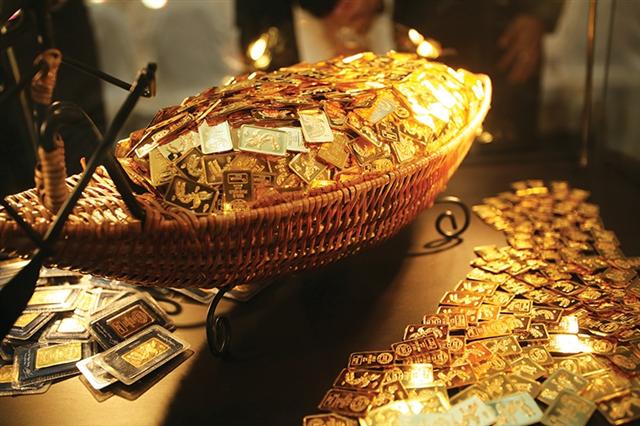Gold price surge here for long haul
Gold price surge here for long haul
Global and domestic gold prices zoomed to a record level amid a weakening dollar and market turbulences pushed by the COVID-19 pandemic.

Gold prices have been consistently rising since 2018 Photo: Le Toan
|
Gold, as the most popular safe haven instrument, has soared almost 35 per cent this year, even outstripping the rally of some blue-chip tech stocks in the Nasdaq Composite Index.
The recent peak marks a fresh milestone in a bull run that began in late 2018 and has gathered momentum during the coronavirus pandemic. The precious metal is on track to notch new records after soaring to over $2,000 a troy ounce for the first time ever in New York trading on July 5.
In Vietnam, the gold bar price has shown no signs of stopping, reaching over VND60 million ($2,600) per tael as of August 7. Domestic gold prices complied with the increase in global ones and maintained a difference of VND1-3 million ($43-$130) per tael above worldwide prices.
One of the major reasons for the rally is that the low interest rates make gold, which does not pay a yield simply for holding it, more appealing for buyers. For example, the Fed’s decision to lower interest rates to just above zero and buy a large quantity of billions of dollars of bonds have impeded yields in fixed-income markets. Even the State Bank of Vietnam (SBV) has signalled that it could cut rates further as stimulus measures to help cash-strapped enterprises tide over the crisis.
Experts believe countries could further slash interest rates to alleviate the economic downturn. However falling interest rates, or even outright negative rates in some nations, would make nervous investors seek safe havens.
In the long run, inflation risks stemming from huge amounts of money for bailout packages and stimulus policies will also heighten buyers’ demand for precious metals.
Some market watchdogs predict inflation to pick up once the economic crunch is over, which would act as a further drag on real yields if nominal rates remain unchanged.
On the flip side, many economies have witnessed cases of infections rise as they reopen – a major concern for investors trying to gauge the path of recovery. That is easily explained, as new worries about public health challenges are fuelling bets on more economic stimulus measures from the world’s central banks and governments.
The allure of precious metals highlights the market volatility, in which stocks, bonds, and other instruments swing wildly as investors weigh up the latest crisis developments. Investors are maintaining bets on gold and silver as geopolitical uncertainty lingers. Another concern is that printing and spending large amounts of money will devalue global currencies, another trend driving bullish wagers on gold.
Hence, gold appears much more attractive, safe, and lucrative when yield has all but vanished from safe havens.
Exness, the market analyst regulated by globally renowned watchdogs such as CySEC, the FCA, and the FSA, saw its trading volume rise to near-record highs in July due to the market volatility experienced, especially with gold trading. Exness has 135,000 clients worldwide and a current monthly trading volume of $585 billion.
“Annual futures on gold have generally maintained a weak contango in the third quarter, with evidence of contracts calibrating towards this,” noted an Exness report.
“Currently the difference between August 2020 and August 2021’s future contracts is around 2.5 per cent, which implies that momentum might slow down into the end of the third quarter of the year.”
From a fundamental perspective, gold is highly demanded in the environment of very low rates and a weaker dollar, noted an Exness analyst. “However, further large buying around the current area remains in question. Even though non-dollar investors can now buy cheaper gold, the price has still appreciated dramatically. A pause for the uptrend while focus shifts back to traders exploiting short-term opportunities in both directions looks likely.”
The gold rally might not be that short-term. Instead, it could be even more persistent, firmly backed by factors that linger through a challenging time, including ultra-low interest rates and global uncertainties stemming from the pandemic and geopolitical tensions.






















